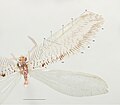Ithonidae, commonly called moth lacewings and giant lacewings, is a small family of winged insects of the insect order Neuroptera. The family contains...
14 KB (1,324 words) - 14:06, 28 July 2023
out of sight and ambush prey from "pits" in the soil. Larvae of some Ithonidae are root feeders, and larvae of Sisyridae are aquatic, and feed on freshwater...
23 KB (1,896 words) - 01:34, 19 March 2024
Ithonidae (moth lacewings) Chrysopidae (green lacewings)...
34 KB (3,779 words) - 07:37, 31 March 2024
genus and first Cenozoic fossil record of moth lacewings (Neuroptera: Ithonidae) from the Early Eocene of North America" (PDF). Zootaxa. 2063: 55–63....
71 KB (7,586 words) - 03:00, 30 April 2024
Makarkin, VN; Wedmann, S; Weiterschan, T (2014). "First record of the family Ithonidae (Neuroptera) from Baltic amber". Zootaxa. 3796 (2): 385–393. doi:10.11646/zootaxa...
22 KB (2,023 words) - 15:30, 5 January 2024
Ithonidae giant lacewings, moth lacewings Myrmeleontiformia...
20 KB (1,490 words) - 13:45, 5 January 2024
Polystoechotes punctata (category Ithonidae)
Polystoechotes punctata is a species of giant lacewing in the family Ithonidae. Found in Central America and North America, this giant lacewing was considered...
3 KB (197 words) - 19:17, 2 March 2023
Ithonioidea Ithonidae (moth lacewings) Chrysopoidea Chrysopidae (green lacewings) Hemerobioidea Hemerobiidae (brown lacewings) Coniopterygoidea Coniopterygidae...
16 KB (1,626 words) - 05:36, 8 December 2023
scorpionflies, saw-flies and in some families of Neuroptera (e.g. Megaloptera and Ithonidae). The function of nygmata are unknown: they do not connect with nerves...
2 KB (158 words) - 19:31, 1 September 2022










